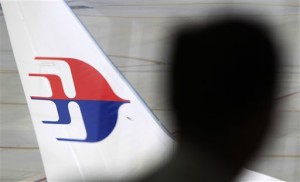
A man looks out from a viewing gallery as a Malaysia Airlines aircraft sits on the tarmac at Kuala Lumpur International Airport in Sepang, Malaysia, Sunday, March 9, 2014. AP
KUALA LUMPUR, Malaysia—Military radar indicates that the missing Boeing 777 jet may have turned back, Malaysia’s air force chief said Sunday as scores of ships and aircraft from across Asia resumed a hunt for the plane and its 239 passengers.
There was still no confirmed sighting of debris in the seas between Malaysia and Vietnam where it vanished from screens early Saturday morning en route to Beijing from Kuala Lumpur. The weather was fine, the plane was already cruising and the pilots didn’t send a distress signal—unusual circumstance for a modern jetliner to crash.
Air force chief Rodzali Daud didn’t say which direction the plane might have taken when it apparently went off route.
“We are trying to make sense of this,” he told a media conference. “The military radar indicated that the aircraft may have made a turn back and in some parts, this was corroborated by civilian radar.”
Malaysia Airlines Chief Executive Ahmad Jauhari Yahya said pilots were supposed to inform the airline and traffic control authorities if the plane does start to return. “From what we have, there was no such distress signal or distress call per say, so we are equally puzzled,” he said.
Authorities were checking on the suspect identities of at least two passengers who appear to have boarded with stolen passports. On Saturday, the foreign ministries in Italy and Austria said the names of two citizens listed on the flight’s manifest matched the names on two passports reported stolen in Thailand.
This, and the sudden disappearance of the plane that experts say is consistent with a possible onboard explosion, strengthened existing concerns about terrorism as a possible cause for the disappearance. Al-Qaeda militants have used similar tactics to try and disguise their identities.
Earlier Sunday, Malaysian Transport Minister Hishammuddin Hussein said that authorities were looking at four possible cases of suspect identities, and that Malaysian intelligence agencies were in contact with their international counterparts, including the FBI, in this regard.
Later, civil aviation chief Azharuddin Abdul Rahman mentioned only two passengers with unverified identities.
Two-thirds of the jet’s passengers were from China. The rest were from elsewhere in Asia, North America and Europe.
A total of 22 aircraft and 40 ships have been deployed to the area by Malaysia, Thailand, Singapore, Indonesia, China and the United States, not counting Vietnam’s fleet.
Li Jiaxiang, administrator of the Civil Aviation Administration of China, said some debris had been spotted, but it was unclear whether it came from the plane. Vietnamese authorities said they had seen nothing close to two large oil slicks they saw Saturday and said might be from the missing plane.
Finding traces of an aircraft that disappears over sea can take days or longer, even with a sustained search effort. Depending on the circumstances of the crash, wreckage can be scattered over many square kilometers. If the plane enters the water before breaking up, there can be relatively little debris.
A team of American experts was en route to Asia to be ready to assist in the investigation into the crash. The team includes accident investigators from National Transportation Safety Board, as well as technical experts from the Federal Aviation Administration and Boeing, the safety board said in a statement.
Malaysia Airlines has a good safety record, as does the 777, which had not had a fatal crash in its 19-year history until an Asiana Airlines plane crashed last July in San Francisco, killing three passengers, all teenagers from China.
Investigators will need access to the flight data recorders to determine what happened.
Aviation and terrorism experts said revelations about stolen passports would strengthen speculation of foul play. They also acknowledged other scenarios, including some catastrophic failure of the engines or structure of the plane, extreme turbulence or pilot error or even suicide, were also possible.
Jason Middleton, the head of the Sydney-based University of New South Wales’ School of Aviation, said terrorism or some other form of foul play seemed a likely explanation.
“You’re looking at some highly unexpected thing, and the only ones people can think of are basically foul play, being either a bomb or some immediate incapacitating of the pilots by someone doing the wrong thing and that might lead to an airplane going straight into the ocean,” Middleton said on Sunday. “With two stolen passports (on board), you’d have to suspect that that’s one of the likely options.”
Just nine percent of fatal accidents happen when a plane is at cruising altitude, according to a statistical summary of commercial jet accidents done by Boeing. Malaysia Airlines Chief Executive Officer Ahmad Jauhari Yahya said Saturday there was no indication the pilots had sent a distress signal.
The plane was last inspected 10 days ago and found to be “in proper condition,” Ignatius Ong, CEO of Malaysia Airlines subsidiary Firefly airlines, said at a news conference.
Greg Barton, a professor of international politics at Australia’s Monash University and a terrorism expert, said if the disaster was the result of terrorism, there is no obvious suspect. If it was terrorism, Barton expected China would be quick to blame separatists from the ethnic Uighur minority, as authorities did recently when 29 people were killed in knife attacks at a train station in the southern city of Kunming.
“If a group like that is behind it, then suddenly they’ve got a capacity that we didn’t know they had before, they’ve executed it very well—that’s very scary,” Barton told AP. “It’s safe to start with the assumption that that’s not very likely, but possible.”
RELATED STORIES
PCG not taking part in massive search for Malaysian airliner, Balilo clarifies
Malaysia probes four names on missing jet’s manifest—minister